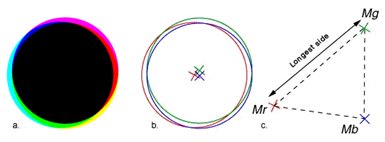Lens refraction depends on the wavelength. This means that magnification not only depends on the image field position but also on the light wavelength. A perfectly sharp edge going from white to black yields a smooth transition showing the decomposition of the light spectrum.
This has two major effects on the sensor. Each channel (usually R, G, B) is blurry because it integrates a certain range of wavelengths that are imaged at different positions on the sensor. Moreover, the different channels are shifted with respect to one another. This usually yields colored fringes along edges with a high level of contrast. DxOMark measures the maximal shift between the three color channels. This measure is a distance.
LCA is expressed in µm on 24×36 mm. 10 µm is a typical level of acceptability.

What does DxOMark measure?
Lateral chromatic aberration is easily computed by considering the image of a black spot on a white background.
Mr is the center of the spot in the red channel, Mg in the green channel, Mb in the blue channel. LCA corresponds to the distances between the positions of Mb and Mg, and of Mr and Mg.

Using a target covered with black dots on a white background, we evaluate LCA all over the field.
We compute statistical data such as maximum and mean values for the image, then we use a color scale to map those values as functions of focal length and aperture value.
We plot curves that represent the variation as a function of the field position of the shifts between the red and green channels on the one hand, and between the blue and green channels on the other hand.
We measure LCA for each focal length and aperture.


 English
English


DXOMARK invites our readership (you) to post comments on the articles on this website. Read more about our Comment Policy.